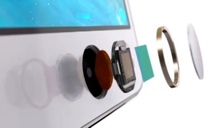The iPhone 5s fingerprint reader: More about convenience than security


Apart from the new gold finish option – for that added 'SWAG!' appeal – the main reason why an existing iPhone 5 owner would want to upgrade to the iPhone 5s is the fingerprint reader. Sure, the CPU and GPU are both twice as powerful as their predecessors, but in your hand you're seriously hard-pressed to feel this bump in performance unless you are a hardcore Infinity Blade fan.
No, the real difference between the iPhone 5s and its predecessor is the Touch ID fingerprint identity sensor that Apple has integrated into the home button. When you lightly touch your finger to the button the metal ring surrounding it sense your finger and the high-resolution capacitive sensor hidden behind a laser-cut disk of sapphire crystal scans your print and quickly decides if you are on the handset's guest list or not.
After only a few minutes of using the Touch ID sensor I was fully converted to its use. Having to physically press the home button and then type in the passcode to wake up my iPhone 5 suddenly felt archaic. That's one of Apple's strong points – taking something that you did habitually and making is much simpler.
But the more I use Touch ID, the more I come to see it as a feature of convenience as opposed to a security feature.
Featured
The problem is that while, as in Apple's own words, "your fingerprint is the perfect password," Touch ID is really little more than a convenient way to enter your passcode, because behind the Touch ID is a passcode, and for most people, that will be continue to be a four-digit passcode. The Touch ID system is little more than an optional extra bolted onto the old passcode system.
Your fingerprint may well be unique, but the four-digit passcode that most people will choose to use as a backup for it won't be.
Now, you could choose a more complicated passcode, or even a password or phrase, and this would increase the security offered. It does, however, bring with it another problem. The more infrequently you use your passcode, the more likely it is to evaporate out of your mind and not be there when you need it.
And because your handset will be locked, you can't rely on being able to retrieve it from a password safe, at least not off the same device.
This is a road that can lead you headlong into a world of pain.
While the Touch ID sensor does bring with it a small increase in security for those who might have previously made use of passcode – since you have to type the passcode in less frequently, there's less of a chance that someone looking over your shoulder will figure it out – the people who really benefit are those who previously would have left their iPhones unprotected because entering in a passcode was too much of a hassle. Now these people get to protect their handset and have a convenient way to unlock it. However, there is still the risk that they will forget the passcode, especially as they don't have one already burned into their minds.
In the short time I've been using the Touch ID sensor I've also found a few oddities with the way it works. For example, depending on how I hold my iPhone, I have to register different fingers in different ways. When I'm holding my iPhone one-handed, I unlock it with the side of my thumb, but when it is held in two hands I use the pad of my index finger, and when it is held in the dock in the car, I tend to jab at it with the tip of my index finger. To get the best out of the Touch ID sensor I have to enroll these fingers in this way.
Another thing I noticed is that when unlocking the handset with the Touch ID sensor, you don't get to see what's on the lock screen notification center, making it easy to overlook a missed call or iMessage.
Another problem is how fingerprints are stored. If you have multiple dabs logged, it can become unclear which is which, and if you let someone else "have a go" then things might get complex. Also, you might overlook the fact that someone with access to your passcode might have added his or her own finger into the system.
While I firmly believe that Touch ID is a step in the right direction – and that we'll be seeing fingerprint sensors not only on the next-generation iPads, but also on a myriad of Android devices – I think it will take Apple some time to refine the system. iOS 7 was the first big change to the platform since it was first unveiled in 2007, and over that time Apple had worked hard to bring the platform up to a level of maturity that iOS 7 is not yet at. While I have great hopes for Touch ID in the future, for now it is little more than a tool of convenience.